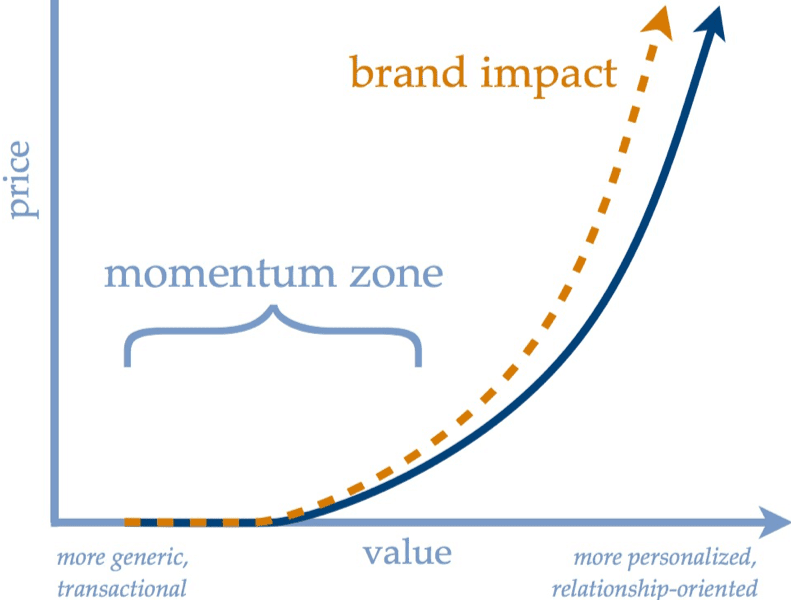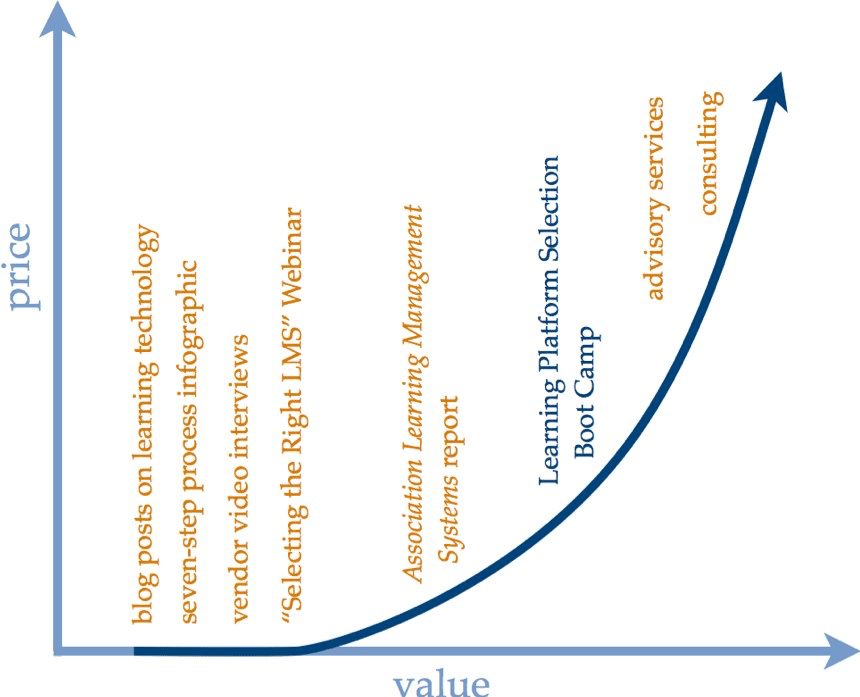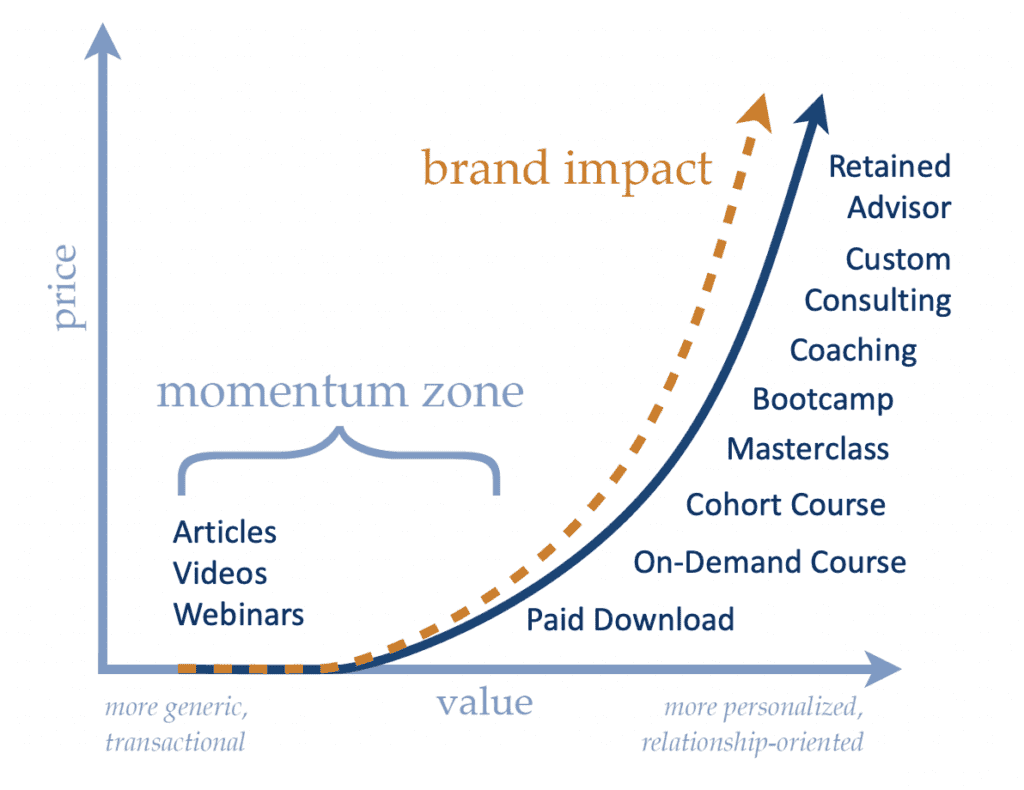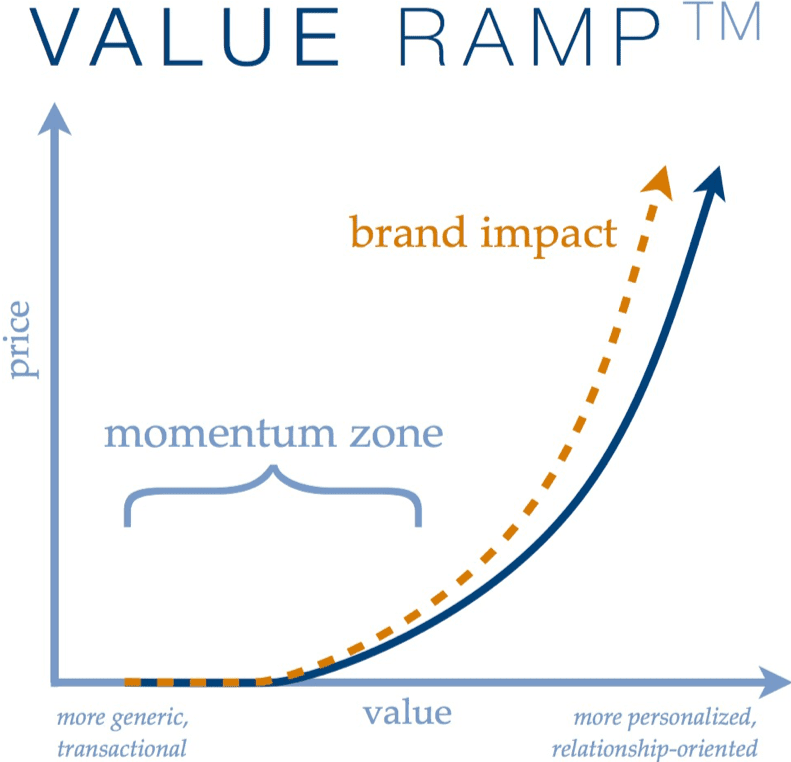

Many people wind up on this site because they are interested in creating and selling online courses, but courses are just one option for leveraging your expertise into a viable business, and they shouldn’t be your only option.
One of our core principles here at Learning Revolution is that you should develop a portfolio of value around your expertise – multiple options at multiple price levels by which people can benefit from the knowledge and experience you have to share.
A portfolio approach enables you to meet your prospective customers where they are, provide value across time, deliver more impact that you ever could with a single courses, consulting or coaching engagement, or other intervention, and by doing all of that, create a much more sustainable and higher revenue business.
At the heart of that portfolio approach is a concept I call the Value Ramp.
What’s the Value Ramp?
In a nutshell, the Value Ramp is a simple, but powerful tool for clarifying that:
- There are many ways in which you can provide value to your customers ‐ not just courses
- The greater the value you provide, the more you can charge
For example, anyone who has the expertise and experience to create a course can potentially do any of the following:
- Blog posts and articles
- Affiliate product referrals
- Podcasts
- Online Videos
- White papers and reports
- Informational Webinars and Webcasts
- On‐demand online courses
- Live seminars (online and off)
- Conferences (online and off)
- Coaching and mentoring (online and off)
- Mastermind groups (online and off)
- Retained advisory services
- Custom consulting
You can probably think of others, but hopefully this list makes clear that you have range of options for building out a portfolio of value.
By doing this, you diversify your revenue streams and you meet your customers where they are. Not everyone wants or needs a course, and depending on the customer’s circumstances, a course may or may not be the best approach to providing value.
The second essential idea underlying the Value Ramp is that there is a positive relationship between price and value: when you provide more value in the eyes of the potential purchaser, you can and should charge more.
(Note: the “in the eyes of the potential purchaser” part is critical. You may be convinced you provide a ton of value, but if your customers and prospects don’t see you this way, you’ll find your sales continually fall short of where you think they should be.)
So, thinking in terms of a portfolio of products and services and higher prices based on higher value, you might plot out something like the following:


This is the actual Value Ramp we used for our technology selection line of services at my company, Tagoras. You can see where courses – in this case, our Learning Technology Selection Bootcamp – fit in, but you can also see the variety of other ways in which we provide value, including the very high‐end advisory and consulting services where, historically, we’ve made most of our revenue.
Blogging, for us, is something that plays a critical role down at the bottom left of the ramp. So do videos (which are free) and Webinars (for which we get sponsors).
These days, you almost always have to provide some proof of the value you can deliver before you even charge a dime. Blogging fits the bill. So do e‐newsletters, brief videos, podcasts, and a variety of other tools that help to create what we call a “Momentum Zone” for driving people up the Value Ramp into paid offerings.
The value of these products and services along the Ramp varies according to:
- How customized/personalized they are to the needs of your customers
- How unique they are in comparison to other options your customers may have
Here, in a nutshell, you have a very simple but powerful approach to developing a strategy for your education/knowledge‐based business. The Value Ramp helps you to think beyond courses and consider the variety of ways in which you might provide value that will attract customers and provide you with multiple ways to monetize your knowledge and expertise ‐ with an eye toward charging more as value increases.
Here’s a more generalized Value Ramp for a coach or consultant:


But Wait, There’s More: Brand and Value
One additional, critical aspect of the Value Ramp is the role that brand can play.
A strong brand helps pull people to your Value Ramp in the first place. In fact, with a strong brand, you can attract people to the higher parts of your ramp right from the start.
And, if your brand is strong, your ramp starts curving upward much more quickly – in other words, you can charge more, more quickly because of how you – and the value you provide – are perceived by your customers and prospects.


The lesson here is that it pays to create a strong brand. That takes time, of course, so you need to have it in mind from the very beginning. (For help with that, be sure to see The 5 personal branding tips edupreneurs haven’t heard before.)
What to Do Next
You can probably guess what the next move is: get out a piece of paper, draw the Value Ramp (two perpendicular line and an upward sloping curve ‐ within the reach of even the most artistically challenged!), and plot out the ways in which you can provide value. You may want to start by plotting your course or courses somewhere on the curve and then asking:
- What am I doing to build momentum toward selling my course(s)?
- What more could I be doing?
- What value could I provide to complement my course(s) and enhance their value -‐ e.g., add-‐on Q&A sessions, mentoring, coaching?
- What additional high‐value offerings could I easily create? Here are some key options to explore:
- Blogging
- Expert-curated affiliate marketing
- Podcasting
- Online Videos
- White papers and reports
- Webinars
- Masterclasses
- In-person seminars
- Virtual conferences
- Online coaching
- Membership site
- Mastermind groups (online and off)
- Retained advisory services
- Custom consulting
- How might you build your brand?
Spend 20 to 30 minutes thinking about the questions, plotting our your ramp, and maybe bouncing off of some people you trust or even some current customers, and you will have a simple but solid product strategy to reference and revise over time.
JTC
See also:
Value Ramp images from Tagoras
Table of Contents



YES. Excellent!